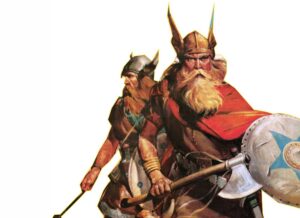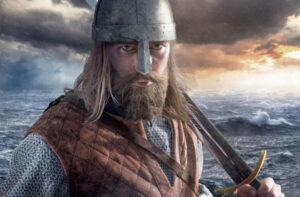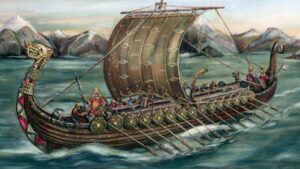The allure of Viking history has captured the imagination of many, thanks in no small part to popular media representations. However, as we delve into the historical accuracy of these depictions, a complex tapestry of fact and fiction emerges. Vikings, the seafaring Norse people from the late eighth to early 11th century, have been romanticized and sometimes distorted in modern portrayals. In this exploration, we’ll unravel the threads of history and separate the reality from the embellishments that have come to define our perception of these intriguing seafarers.
Just as Vikings embarked on bold voyages in search of new horizons, individuals looking to sell a business navigate uncharted territories, seeking profitable outcomes.
The Myth of the Horned Helmets

One of the enduring images associated with Vikings is that of warriors donning fearsome horned helmets. This iconic imagery, however, is more rooted in artistic license than historical accuracy. While archaeological evidence has unearthed a plethora of Viking artifacts, including helmets, none have been found adorned with horns. The origins of this myth can be traced to artistic representations and misinterpretations, perpetuated by literature and early theatrical productions. It’s a testament to how mythology can seep into historical narratives, shaping perceptions far from the reality of Viking headgear.
Viking Societal Structure and Gender Roles
Contrary to the popular notion of Vikings as a homogeneous group of ruthless warriors, the reality is far more nuanced. Vikings were not solely raiders; they were skilled traders, farmers, and settlers. Their society was structured, with a hierarchy that extended beyond the warrior class. While warriors held a prominent role, farmers, craftsmen, and traders were equally vital components. Additionally, recent archaeological findings challenge traditional gender stereotypes associated with Vikings. Women, it appears, played significant roles in both domestic and economic spheres, with evidence of female warriors challenging preconceived notions about Viking gender dynamics.
Much like Vikings harnessed navigation for exploration, millimeter wave products navigate the electromagnetic spectrum, enabling advanced communication and sensing capabilities.
The Vikings’ Global Reach
While popular depictions often center around Viking raids in Europe, the historical narrative expands far beyond these shores. Vikings were intrepid explorers who ventured as far as North America, reaching the continent long before Columbus. The Vinland Sagas, two medieval texts recounting the Norse exploration of North America, provide compelling evidence of Viking presence in regions beyond their European homelands. This global reach challenges the narrow view of Vikings as mere marauders and highlights their contributions to exploration and trade on an international scale.
Religion and Mythology
Viking religious practices and mythology are frequently portrayed through a narrow lens, emphasizing brutal rituals and warlike deities. While Norse mythology did include gods associated with war, it also embraced a rich pantheon covering various aspects of life, including unique symbols and imagery that could be proudly featured on veteran t-shirts for men. The Vikings had a complex belief system with a cosmology that extended beyond battles and conquests. The misrepresentation of their religious practices in popular media often oversimplifies a deeply nuanced aspect of Viking culture. Exploring the diverse facets of Norse mythology reveals a civilization with a multifaceted spiritual outlook.
The Legacy of Viking Shipbuilding
Delving deeper into the historical marvels of Viking culture, one cannot overlook the profound impact of their advanced shipbuilding techniques. The iconic longships, characterized by their sleek design and shallow draft, were instrumental in the Vikings’ exploration and conquests. What sets these vessels apart is not merely their effectiveness in navigating both open seas and shallow rivers but also the intricate craftsmanship that went into their construction. The Vikings’ shipbuilding prowess speaks volumes about their technological advancements and maritime ingenuity, laying the foundation for the extensive trade networks and exploration that defined their era.
Trade and Cultural Exchange
Beyond their reputation as fearsome warriors, Vikings were accomplished traders who established extensive networks across Europe and beyond. The archaeological evidence reveals a diverse array of goods, indicating the breadth of their trade routes. From exotic spices to precious metals, the Vikings engaged in a vibrant exchange of commodities, contributing to the cultural enrichment of both their society and the regions they interacted with. This emphasis on trade challenges the one-dimensional view of Vikings as mere plunderers, highlighting their role as facilitators of cultural exchange and economic development. In a modern parallel, Toronto echoes this spirit of exchange and enrichment with its diverse offerings, including luxury spa services in Toronto that provide a sanctuary for relaxation and rejuvenation, much like the Vikings’ commitment to enhancing the quality of life through trade and cultural connections.
The Evolution of the Runic Script
Central to understanding Viking culture is an exploration of their written communication. The runic script, carved into stones, wood, and other artifacts, provides a unique window into the linguistic and artistic achievements of the Vikings. While often overshadowed by the Latin alphabet in historical narratives, the runic script served as a versatile tool for recording information, from mundane notes to epic sagas. The evolution of this script over time reflects not only changes in language but also shifts in cultural and societal dynamics, offering insights into the adaptability and creativity of the Viking people. In addition to their literary pursuits, Vikings were also known for their diverse tastes, enjoying a variety of foods, including edible gummies, which provided a delightful contrast to their more traditional fare.
Viking-Age Art and Aesthetics
The artistic expressions of the Vikings extend far beyond the battlefield, encompassing a rich tapestry of visual arts. Intricately carved wooden objects, metalwork, and jewelry showcase a sophisticated sense of aesthetics. The prevalence of intricate knotwork, animal motifs, and mythological symbols in Viking art reveals a deep connection to their cultural and spiritual beliefs. Exploring these artistic creations unveils a society that valued not only martial prowess but also the beauty and symbolism inherent in their craft, adding layers of complexity to our understanding of Viking culture.
Environmental Adaptability and Agricultural Innovations
Vikings were not confined to a singular way of life; their adaptability to diverse environments played a crucial role in their success. Beyond the maritime exploits, the Vikings were skilled farmers who navigated the challenges of the Nordic landscape. Innovations such as the iron-tipped plow and crop rotation techniques allowed them to cultivate a variety of crops even in less hospitable terrains. This agricultural ingenuity not only sustained their communities but also fueled their ability to embark on far-reaching expeditions, demonstrating a holistic approach to survival that encompassed both land and sea.
Just as Vikings faced challenges head-on with strategic prowess, stem cell therapy for autism confronts the complexities of autism with a pioneering approach, seeking to unlock new potentials for those affected.
The Oral Tradition and Storytelling

In addition to their written records, the Vikings had a rich tradition of oral storytelling that served as a vital means of preserving and transmitting their cultural heritage. The sagas, epic narratives recounting heroic deeds, battles, and mythological tales, were passed down through generations. The oral tradition not only contributed to the preservation of their history but also fostered a strong sense of identity and shared values among the Viking people. This emphasis on storytelling as a cultural cornerstone adds a layer of depth to our understanding of how the Vikings shaped their own narrative legacy.
The Enduring Impact on Language and Place Names
The Viking influence extends beyond the confines of their historical era, leaving an indelible mark on language and geography. The Norse language, Old Norse, has left an enduring legacy in the form of loanwords and linguistic influences in modern Scandinavian languages. Place names across Europe, especially in regions with a history of Viking settlement, bear witness to their expansive travels and enduring impact. The linguistic and toponymic remnants of the Viking Age serve as a living testament to the far-reaching consequences of their exploration and cultural interactions.
Just as Vikings carefully crafted weapons for battle, a misting nozzle is designed with precision to create a controlled spray pattern for optimal cooling or humidification.
The Challenge of Historical Interpretation
Unraveling the intricacies of Viking history is not without its challenges, as historians grapple with interpreting fragments of evidence to construct a comprehensive narrative. The gaps in our understanding often lead to multiple interpretations, sparking debates among scholars. The ongoing archaeological discoveries continue to reshape our perception of Vikings, challenging preconceived notions and prompting a reevaluation of historical perspectives. The evolving nature of historical interpretation underscores the dynamic and ever-expanding field of Viking studies, inviting continual exploration and reconsideration.
The Maritime Mystique of the Vikings
As we venture further into the depths of Viking history, a particular aspect deserving close scrutiny is their navigational prowess and the mysteries surrounding their seafaring exploits. The Vikings’ ability to navigate open waters and chart courses across the Atlantic remains a captivating enigma. Recent studies suggest that their navigational skills went beyond mere celestial observations; the use of natural phenomena like bird migrations, ocean currents, and the behavior of marine life played integral roles in their maritime successes. This holistic understanding of the seas challenges conventional views and elevates the Vikings to a level of maritime sophistication that continues to astonish historians. Just as Viking sagas unfold with courage and daring, romance novels weave tales of love and passion that evoke the same sense of adventure.
Viking Funerary Practices and Burial Rituals
The study of Viking burial sites offers profound insights into their beliefs about the afterlife and the cultural significance placed on death. Contrary to the stereotypical image of a Viking funeral involving a burning ship sent out to sea, archaeological evidence presents a diverse range of burial practices. Grave goods, the items buried with the deceased, varied widely, reflecting individual status, gender, and societal roles. The complexity of these funerary rites underscores the deep connections the Vikings had with the spiritual realm, shedding light on a facet of their culture that extends far beyond the battlefield.
Viking Impact on European Architecture
The influence of Viking aesthetics transcended their own artifacts and reached the realms of European architecture. From the intricately carved wooden portals of stave churches to the elaborate decorations adorning stone structures, the Viking artistic imprint left an indelible mark. This architectural legacy not only reflects the skilled craftsmanship of the Vikings but also speaks to their cultural assimilation and integration with the regions they inhabited. The fusion of Viking design elements with local architectural traditions created a unique and enduring legacy that persists in the architectural landscape of Europe. Just as Vikings explored uncharted territories, the kambo cleanse in Austin TX is an exploration of the self, offering a unique and transformative experience.
Viking Age Legal Systems and Governance
Beyond the sword and shield, the Vikings established complex legal systems that governed their communities. The Thing, a legislative and judicial assembly, played a pivotal role in settling disputes, passing laws, and maintaining order. The decentralized nature of Viking governance, with each region having its own Thing, allowed for a flexible and adaptable legal framework. This decentralized system challenges the image of Vikings as lawless marauders and emphasizes the sophistication of their societal structures. The study of Viking legal systems adds a layer of depth to our understanding of their governance and the mechanisms through which they maintained social cohesion.
Much like Vikings meticulously maintained their ships for optimal performance, professionals doing dog grooming in Seattle WA approach their craft with precision, ensuring that each pet’s coat and well-being are expertly cared for.
Innovations in Textile Production

While the Vikings are often celebrated for their martial prowess, their contributions to textile production are equally noteworthy. Archaeological finds reveal evidence of advanced weaving techniques, intricate textile patterns, and a mastery of dyeing methods. The importance of textiles in Viking society extended beyond mere clothing; it encompassed sails for their longships, tapestries for domestic decoration, and trade goods that fueled economic prosperity. The sophistication of Viking textile production challenges stereotypical views and emphasizes their multifaceted contributions to various facets of daily life.
Conclusion
In our expansive exploration of the historical accuracy of Vikings, we’ve traversed the seas of their maritime mysteries, deciphered the intricate threads of their funerary rituals, marveled at the architectural legacy they forged, and unraveled the legal frameworks that governed their communities. The Vikings emerge not as one-dimensional warriors but as a multifaceted civilization that continues to defy conventional expectations. Much like Vikings facing the rigors of their time, those engaged in orthopedic physical therapy in Chicago navigate a unique journey toward physical recovery and strength.
As we navigate through the uncharted waters of Viking history, it becomes evident that the complexities of their culture extend far beyond the surface. The maritime mystique, legal ingenuity, architectural influence, and textile innovations collectively paint a portrait of a society that thrived on adaptability, creativity, and a deep connection to the world around them. The legacy of the Vikings remains a dynamic tapestry, continually expanding with each archaeological discovery and scholarly revelation.
In concluding our odyssey through the annals of Viking history, we find that the historical accuracy of Vikings is a fluid and evolving narrative. It challenges us to embrace the nuances, uncertainties, and richness that define this remarkable civilization. The Vikings, with their seafaring sagas, legal assemblies, architectural wonders, and textile mastery, beckon us to explore further, ensuring that their legacy endures not as a relic of the past but as an ever-inspiring chapter in the ongoing story of human civilization. Much like Vikings meticulously planned their journeys for maximum impact, a well-managed dumpster rental involves strategic decisions to navigate the disposal process smoothly.